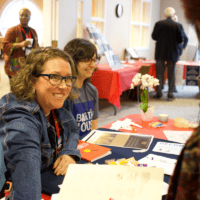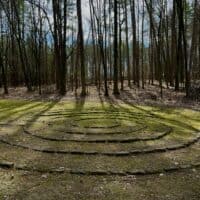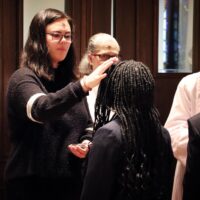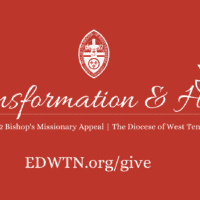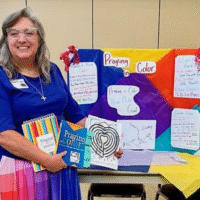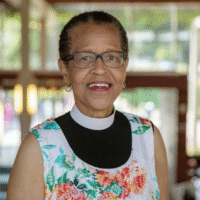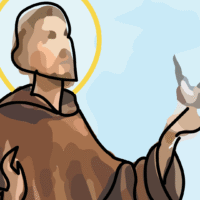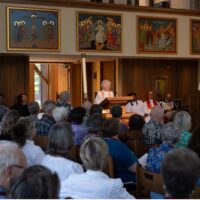This past Lent and Easter, five small Episcopal communities in Memphis—Barth House Episcopal Center, Holy Trinity, All Saints’, Emmanuel, and Church of the Good Shepherd—came together in a bold act of faith and fellowship. In pooling their people, worship spaces, and liturgical responsibilities, they created something larger than the sum of their parts: a Holy Season that felt fuller, richer, and more deeply connected to the heart of the Gospel.
This wasn’t the first time something like this had happened. “It actually started in 2023 with just Good Shepherd and Holy Trinity,” said the Rev. Hester Mathes, priest-in-charge at Holy Trinity. “Noah [Campbell], who at the time was vicar of Good Shepherd, and I were both trying to figure out how to survive Holy Week as solo clergy—but also how to make these midweek services feel alive. When you’ve got seven people from each congregation, suddenly a service of 14 feels like a real, vital gathering.”
That spark of vitality soon grew. “Emmanuel invited us to their Shrove Tuesday Pancake Supper,” Rev. Hester recalled. “And from there, we invited them to join us for Maundy Thursday and Good Friday.” In 2024, All Saints’ Episcopal Church joined the mix, and this year, Barth House officially came on board. “Although we had technically hosted Ash Wednesday in 2024, this was the first year we were fully part of the rotation,” said Maggie Schaumleffel, Director of Ministries at the Barth House. “And it felt good to be on the schedule—not just hosting, but really participating.”
That full participation led to moments of grace that were both tender and transformative. Maggie brought several college students with her to services throughout the season, many of whom do not identify as Episcopalian—and some who are actively deconstructing their past religious experiences.
“The idea of walking into a worship space—any church space—is hard for a lot of our students,” Maggie shared. “But I could say to them: ‘I believe we are safe in this space. I trust these people with you.’ And when they were met with love? Whew. I was just so proud. It was like, ‘These are my babies—and this is a church I trust to love them well.’”
The emotional resonance of the season wasn’t limited to college students. “On Easter, I met Anne Marie Motley, the senior warden at Holy Trinity,” said Beverly Holmgren of All Saints’. “We just had the nicest chat. She was so warm and animated, and it reminded me why we do this—to connect. That’s what being the Body of Christ is about.”
Other cross-congregational relationships blossomed. “At the Small Church Conference, I met Joyce from Good Shepherd,” said Nedra Bailey of Emmanuel. “During the conference, we decided to be prayer partners, but we didn’t exchange our contact info at the time. Then we saw each other again on Easter and said, ‘Let’s actually do this.’ So now we talk every Thursday.”
The beauty of the services themselves left a lasting impact. From choirs combining at Holy Trinity, to the Stations of the Cross beginning with chant at All Saints’, each liturgy was enriched by the unique traditions and talents of its host. “I’ll never forget when John Vargas from Good Shepherd chanted the Gospel one Good Friday,” said Rev. Hester. “It was stunning. People from Holy Trinity had never experienced it done that way, and it was so moving. That’s the gift of doing this together—we share what makes each of us special.”
Even practical details—often the behind-the-scenes stress points of Holy Week—became occasions for collaboration and joy. Bulletins, for example, were produced by combining the forces (and printers) of Holy Trinity and All Saints’. “We printed the covers at one church and the inside pages at the other,” Rev. Hester explained. “Then we sat around and stapled them together. I’ve never had so much fun collating bulletins!”
There was, of course, a lentil soup contest. (Because Episcopalians never miss a chance for a potluck with bragging rights.) “What Good Shepherd did so well was make their Maundy Thursday hosting into a community-building event,” said Maggie. “Instead of dreading having to make soup, they turned it into a joyful competition—and made it a signature moment in the week.”’
But what happens when congregations share an Easter service—and with it, the Easter offering? “We just asked everyone to either give online to their home churches, or write checks and drop them in envelopes marked for their own parish,” Rev. Hester said. “Then a representative from each church came forward and distributed them after the service. It worked beautifully. The cash offerings helped cover shared costs, like security and the reception.”’
That kind of coordination extended to attendance numbers too—something that’s still reported to the diocese each year. “We decided that each church would simply count their own people, and report those numbers. That way, everyone still gets to count Easter in their average Sunday attendance, which can be a really important data point for small churches.”
Beyond numbers and logistics, though, the experience offered something more profound: an ecclesiology rooted in relationship.
“Year after year, it starts to feel like a family reunion,” Rev. Hester said. “Instead of learning names, you’re reconnecting with people you’ve come to know and love.”
And it’s not just fellowship for its own sake. “When our Barth House students went to Emmanuel, we talked on the way home about the history of that church—its legacy as a historically Black congregation,” Maggie said. “They didn’t grow up with that context. To be invited in and included in that story—it mattered.”
For Nedra, whose church is navigating the challenges of generational change, the collaboration is both a blessing and a stretch. “Some folks don’t want to change,” she said honestly. “They want things the way they’ve always been. But this ‘shuffling around,’ as I call it, is our new normal. And honestly? I love it. It connects us. It wakes us up.”
Each church brought its own flavor—sometimes literally. Barth House brought students, Emmanuel brought hospitality, All Saints brought music, and Holy Trinity brought the table. And yes, Good Shepherd brought the lentil soup—three kinds, in fact.
“They kind of had a lentil soup contest,” Maggie explained. “They made it into something joyful and communal, not just a task on the calendar. It helped fuel fellowship activities leading up to Maundy Thursday.” What started as a simple meal had become a tradition. “That lentil soup Maggie made the first year?” Rev. Hester added. “It’s now part of the signature of our Holy Week walk.”
Banner day for lentils, indeed.
“What stood out most to me,” Beverly said, “was having a full church, with people praying together. At All Saints’, we love each other—but we’re tiny. It’s so nice to feel like we’re part of something bigger.”
That sense of “bigger” was felt in every borrowed pew and lentil spoon. “This is how church began,” said Maggie. “People were brought in, cared for generously, and loved authentically.”
As for what’s next? Christmas Eve collaborations are already on the table. “The first year Emmanuel and Holy Trinity worshiped together for Christmas, it was amazing,” said Nedra. “It turned out great. We’re just getting started.”
And with each season, this grassroots partnership grows deeper, stronger, and more joyful.
“We didn’t sit in a meeting and decide to do this,” said Rev. Hester. “It happened organically, because the Holy Spirit is moving through our churches. This is what it looks like to be the Church together.”




